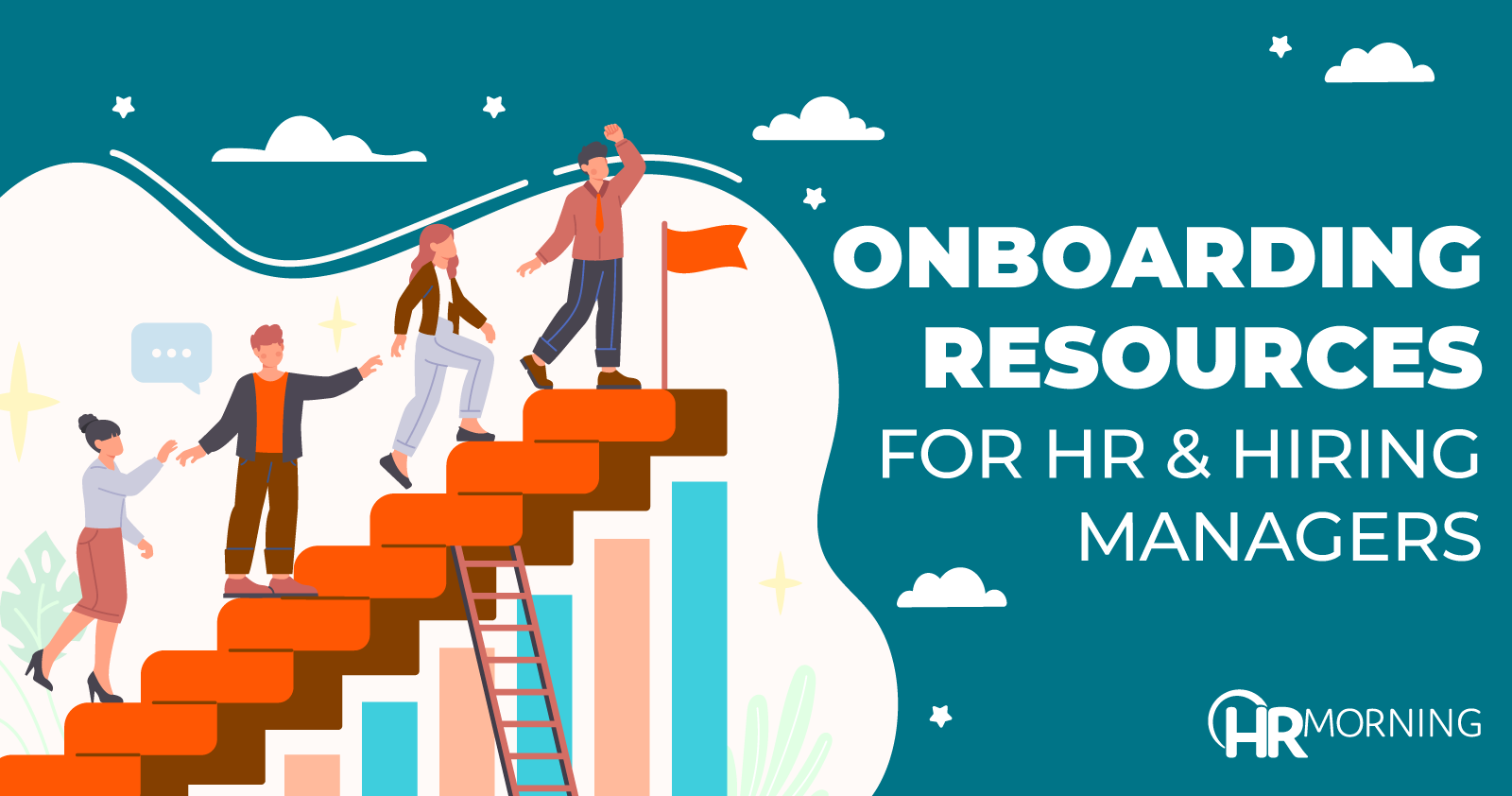
The first few days and weeks when new employees come to work for your organization can be a make-or-break time for them.
A positive welcoming experience puts them at ease: It reinforces the feeling that joining your company was a great decision.
That good feeling can carry over for years to come as good people develop an appreciation for their work and the organization they work for. That breeds loyalty – a key component of a stronger workforce, and an essential characteristic of what keeps organizations going strong.
There’s lots to cover. Click to jump ahead.
- What is Onboarding?
- Why Onboarding is Important
- The Onboarding Process
- Job Orientation
- Onboarding Checklist
- Other Onboarding Best Practices
- The Final Step
What is Onboarding?
Onboarding is the process of integrating employees into the work environment and providing them with good reasons to feel comfortable about the job. It should be a key part of every organization’s talent management plan.
A Successful Onboarding Process:
- Establishes a strong employer welcome.
- Affirms the employee made the right job choice.
- Allows the employee to see how she or he fits in with the organization.
- Sets the stage for long-term relationship building, which improves retention.
Onboarding is often called the last stage of the recruitment process – and the first step toward retention.
Done well, companies benefit from employee onboarding and sound new hire orientation by creating a stronger workforce and valuable long-term relationships, which makes for a more productive and profitable company.
Worth the Read:
- Onboarding in 2019: What a Knock-Out First Day Should Look Like
- Onboarding: First-Week Tactics That Pave the Way to Success
- The Critical Onboarding Mistake 67% of Employers Make
Why Onboarding is Important

Onboarding best practices really do matter. It’s been shown that if an employee stays with an organization for 18 months, the chances that person will remain with that same company well into the future skyrocket.
The most crucial part of these 18 months is the first few days for the new hire. This is the time when they decide whether the organizations feels like a good fit or if they should keep sending out resumes to other potential employers.
The cost of bringing on a new employee keeps climbing, too.
Depending on the position and how long it takes to find a qualified candidate, companies can easily expect the cost of turnover to be 150% of an employee’s annual salary.
That means a worker who makes $50,000 a year could cost you $75,000 to replace.
And that figure doesn’t even include the impact on morale of other employees who are observing the turnover.
With so much money on the line, getting the right candidate to stay with your company takes on more importance than many employers give it credit for. The financial incentives for keeping them on alone make onboarding an important process.
The Onboarding Process
A lot of the nitty-gritty of the onboarding process will be the work of HR professionals. They’ll handle setting up an employee with the right paperwork and policies.
But the most important work to be done – that which has a direct impact on a person getting acclimated to a new environment – is the responsibility of frontline managers and supervisors.
These are the people who prepare the workplace for the employee – and prepare the employee for the workplace.
This report provides guidelines for what you should do – and when – in order to make new employees feel welcome and valued, and to make sure they can start being productive parts of your workplace sooner than you thought possible.
To get the relationship off on the right foot, it all starts with putting in work ahead of time.
Make an Onboarding Checklist
It’s easy to forget a minor detail here and there – there’s a lot that goes into welcoming new employees.
That’s why it might be a good idea to make a checklist. Include all the things you’ll be discussing with them, need them to sign and want them to do.
It helps to have a recently hired employee look over the list to see if there’s anything missing, since it’ll be most fresh in the mind of someone recently hired.
New Hire Orientation

The first day for new hire orientation should be highly energized and positive.
You’ve already picked them! There was something about this person that made your organization say they were the one you wanted.
And they’ve picked you, as well. Something made them accept your invitation to an interview. And it got them to accept the position when it was offered.
The interview process is a good place to start when welcoming new candidates aboard. Think back: What were some of the things that stood out?
Draw on these to make their first day more comfortable.
For instance, did you talk about a favorite sports team? If so, take the liberty of putting their name tag on the team’s emblem. Did they mention their family? Put a picture frame on their desk that they can use for a family photo.
By the time new hires start, they may have forgotten some of the good vibes they had from the interview. Bringing their memories back to the hiring process shows you still remember them.
And it reassures candidates they’ve made a great impression in your mind.
Job Orientation
Imagine stepping off a plane in a new city. From the minute you walk out of the airport things feel … different.
You’re surrounded by unfamiliar sights. You don’t know anyone. Things seem to be moving at a slightly different speed.
This is what the first few minutes of a new hire’s first day on the job are like.
Sure, they’ve been places like this before, but they haven’t been here.
And they’re going to need some time to get used to it.
This isn’t the time to launch right into department introductions and a building tour. Give them the time to get acclimated to their surroundings.
And most importantly, give them something to do. Provide a sheet of paper that walks them through logging onto your email and recording a personal voicemail.
No matter how simple it is, keeping their mind on a task gives new hires a chance to acclimate themselves and start the process of feeling comfortable with their new surroundings.
Worth the Read:
- A New Look at New-Hire Orientation
- 5 Simple Ways to Make Your New Hire Feel Welcome
- 7 Reasons New Hires Hate Their First Day
Providing a Contact
So the employee has been brought into the building, shown their desk and set up with something to do.
But what happens if they have a question? Or 17 questions?
Whether it’s you or a fellow co-worker, you’ll want to have someone on call for your employee to talk with.
In some cases, this could be a mentor – a seasoned employee who knows all the ins and outs of the company.
Other times, you may want to assign an orientation fellow – a recently hired employee or one with a similar professional background.
An orientation fellow should be someone who remembers what it’s like to be starting a new position and has had a positive experience with the job.
When recruiting the contact for the company, make sure you have a good fit. Select someone who genuinely wants to help a new employee and has the time to do so. Don’t make it just another task on an already overburdened employee’s to-do list.
Touring the Building
The typical next step for welcoming an employee on board is the building tour. “Here’s the printer, here’s the bathroom,” etc.
OK, that’s good information to have. But is it really going to stick out in an employee’s mind?
A better bet is to give them the “insider’s tour.” Which areas of the building have spotty Wi-Fi coverage? Where can they grab a coffee mug if they forgot theirs at home? What’s a quiet place to get some work done if office conversations get a little too loud? Which fridge should they put their lunches in? What do they do if they lose their security card or key?
Little tidbits like this go a long way toward making an employee feel like they are part of the place. You’re not just showing them the way, you’re showing them how things get done.
And you’re giving them the kinds of info they’d want to know, but that would take a long time to get on their own.
Showing you’re an ally and a resource of information is the real key. Doing so sets you up not just as a supervisor or manager, but as a trusted and helpful one.
Introduction to the Workplace

Introductions should be inclusive, but not overbearing. Obviously, it would be nice if employees got to know everyone in the company right off the bat.
But expecting someone to get to know and remember the names of so many people in the span of one morning isn’t realistic.
Try this: Don’t introduce people based on their title. Introduce them based on their working relationship with the employee.
For instance, instead of, “Meet Bill. He’s our payroll clerk,” say, “Meet Bill. He’ll collect your time sheet every week and he’s the person to see if you have any questions about your paycheck.”
You may even want to include this blurb on a list of names for everyone the employee will meet. Check off the name as the employee meets the person, and include the person’s phone extension and email address to save the new hire the time it would take to look it up otherwise.
After you’re done with the scheduled introductions, send an email to the office. Let them know the new hire has officially come on board and give a little information about them and where they’ll be sitting.
Then invite everyone who hasn’t met the employee yet to drop by and say hello when they get the chance.
Send this invite a few hours after scheduled introductions finish. A second wave of people coming and introducing themselves immediately after they’ve just finished scheduled introductions may wind up with the employee feeling a bit overwhelmed by new names and faces.
Onboarding Checklist
There are plenty of documents and papers employees will need to do their jobs.
Here are some examples of what to include:
- The mission/purpose statement. If your company has a mission or purpose statement already, this comes first. Put it on the first page of the binder so employees know what’s expected. If you don’t have an official statement, just have a brief message.
- Here is a can’t-miss statement if you don’t already have a mission statement: “We’re a company that respects all our employees – from new hires to established vets – and are really looking forward to having you contribute in a meaningful way! Welcome!”
- A building map. Try to include the names and phone extensions of other employees on the map where they work. That way, new hires can see where to go to pick up that document someone has ready for them.
- Phone extension/email list. If you can prioritize this list by listing the employee’s department first, so much the better. That way, they don’t have to hunt for the name they need (or worry about forgetting which “Jim” mans the help desk and which one is the CFO!).
- A company “facebook.” Well before the popular social network of the same name, these books were made for incoming freshman in college to put a name to the face for their classmates. Why not do the same with pictures of company VIPs (and other key contacts)?
- Daily schedules. You should have the employee’s first day (or first few days) planned for him or her. Include the schedule so they know what’s coming next.
- Long-term schedules. When can they start taking vacation or enrolling in the company’s 401(k)? When will their first formal/informal review be? When can new workers start accumulating sick days? Having these key milestones on a timeline helps employees see what’s next for them, and gets them thinking about their long-term future with the company.
- HR documents. Employees will need to receive policies and procedures, benefits enrollment forms, etc. Include these in the folder, but be sure to have someone from HR go over them with the new hire in-person as well – in case there are questions.
Other Onboarding Best Practices
In addition to these standard items, try including some of the following sections as well:
- “What I learned … “ Collect anecdotes from employees on the most important thing they picked up in their jobs. What was the moment that made them say “A-ha!”? It doesn’t have to be anything ground- breaking, just a musing on what people have learned about the workplace along the way. Include a list of one-sentence-or-so anecdotes to make new employees feel welcome (and maybe chuckle a little.)
- Success stories. Chances are someone in your company has recently come up with a new way of doing things that’s really saved time or reduced frustration. Or maybe they’ve achieved a milestone (1,000th sale, 35 years with the company, etc.). Maybe they’ve even had a personal accomplishment such as running a race or organizing a charity fundraiser.
- When you hear stories like these, share them. Write a short paragraph about it, then include it in a “News & Notes” or “Success Stories” section of the onboarding material. This way, new employees will feel as if they’re getting to know their co-workers right off the bat.
- The “Lingo Board.” Managers and supervisors will often find themselves casually dropping an acronym or industry-specific term with a new hire and being greeted with a slack jaw or confused stare.
Each workplace has its own set of terms and lingo that is specific to the company. It’s not a bad thing, these shortcuts are real time-savers when people know their meanings. But until workers are up to speed on the office language, provide a list of terms and definitions. Put it in plain English so they can see what they should be looking for when you ask for “a DBC report.”
Of course, all the documents in this packet should be available on the company intranet as well, but having a one-stop resource for employees on- hand will be a good way to keep them in the loop from the very start.
Worth the Read:
- 6 Add-Ons Any Onboarding Program Would Benefit From
- 7 Reasons New Hires Hate Their First Day
- 5 Onboarding Tactics That Get Long-Term Results
Being a Good Closer
At the end of the worker’s first day, you’ll want to close out strong. Have a brief one-on-one with the employee to review what they did and whom they spoke with.
This shouldn’t be an in-depth meeting: Just take five minutes or so to see if they have any more questions and touch on what they’ve learned. Keep it light. (Throwing in light-hearted comments like, “Don’t worry, John’s not as intimidating as he seems!” goes a long way toward acknowledging their stress and comfort levels might be put to the test.)
Then, let the new hire go home.
You may have noticed not much work has gotten done on the first day: and that’s by design. Throw them into the fire too soon, and new employees’ minds will be racing.
First days are for first impressions. There will be time for getting to the real work.
For now, leave them feeling good about their experiences and ready to start in earnest the next day.
Easing workers into the job is the name of the game. The first week is the time to start giving them real responsibilities, however.
While you’ll want to turn workers loose sooner rather than later, doing so too soon can create problems. That’s why many workplaces have found mentoring or other programs to be beneficial.
Bringing In a Mentor

No one should have to go it alone.
Having some sort of mentor relationship can be beneficial to new hires.
But there are many routes you can take for the designated contact within the department. Choosing the one that’s right will require getting to know the employee’s personality type and matching him or her with someone who has similar attitudes.
- Peer mentors. Some people will be naturally comfortable working with and talking to an employee who’s around the same age and experience level. For instance, a recent college grad might be more at ease if their contact is a younger employee who had started working for your company recently as well. Likewise, someone who has been working in the field for a while but is new to your organization might appreciate being paired with someone who is also more experienced.
- Veteran mentors. If you feel like a new employee could use an expert to consult with and get guidance from, a veteran mentor could be a better fit. Find someone who is knowledgeable about the industry and your company, has a solid track record and is willing to spend some time giving guidance.
- Shadows. If you don’t think an employee needs a formal mentor, a shadow may be the next best bet. Have new employees follow and observe someone while they do their job. Then have the shadow turn around and help observe the new employee, as well, once he or she’s ready to start doing work solo. Shadow employees should be ones who are patient, sticklers for following procedures and who have proven track records.
- Independent mentors. Sometimes, it can be uncomfortable for new employees to be paired with someone they’ll be working closely with.
Consider having a veteran employee who isn’t necessarily on the same line or in the same department check in with the employee once a day about 15 minutes before quitting time.
This mentor can be a trusted, confidential person to talk to about any concerns a new hire might have. It’ll also boost the new employee’s confidence by giving him or her someone to ask questions to without fear of looking “dumb” or confused. It’s also a good way to get questions answered that aren’t so crucial they need to be asked immediately.
Getting Started Again
You’ll want to greet the new employee on their second day just like you did on the first. Then get them started on a simple assignment right off the bat.
For instance, if they’ll be working with customers, have them call up a few current customers and give them a quality survey to complete over the phone. If they’re going to be working on the floor, have them observe the goings on and answer questions about what they observed after the shift ends.
These smaller assignments will help new employees get a feel for your company and a taste of the kinds of things they’ll be doing when they’re starting in full.
Note: Your company may have specific safety, privacy or other training that needs to be completed before work is to begin. Obviously, these should be completed before work begins.
Start With the Hardest Parts
Some employers are reluctant to give difficult projects to newer hires. But the truth is, experience is a great teacher. Within the first few days, new employees should be trying to tackle more difficult tasks.
After the initial assignment, get them to work right away on something bigger and more complicated.
Why? For one thing, it’s why they were brought on. If you spend too long getting them up to speed with busy work or smaller assignments, you’re not getting the most out of an employee. This isn’t a summer intern: It’s someone you’ll be trusting to propel your organization to greatness.
Besides, it’s what good employees want. Believe it or not, a big reason many people leave their jobs is that they don’t find them challenging enough. If they feel the job is going to be nothing but simple introductory tasks, workers will be unlikely to think it’s on their level of expertise.
On the other hand, compare that to telling a new worker: “We’re about to give you a big project. We know you can do it, and we’ll give you the tools and help you need to be a success.”
This puts trust in the worker, inspiring him or her to rise to a challenge. It’s much more rewarding to hear you’re trusted than to feel as if you need to earn the right to be trusted.
Group Projects or Individual Assignments?

There are two schools of thought on the best kinds of assignments for new employees.
The first is that it’s best to start them with a group project. This will help them get to know their co-workers, contribute to the team and start working on a big assignment right out of the gate.
The other is that individual assignments are best. These are an opportunity to see what workers can do when they’re given individual responsibilities. It’s a good way to find out what they’re capable of.
Which method is best? It depends on the worker. But both methods should be given a shot, if possible.
It’s a good way to evaluate a new hire’s strengths and weaknesses – and to find the best fit for him or her within the company.
Getting Them Involved
In addition to the first work assignments they’re given, this is an ideal time to get employees involved in the company’s culture.
Make sure fresh employees are educated and recruited to some of the opportunities not directly related to their jobs.
Do you have a company softball or bowling team? Does your organization support volunteering or charity opportunities? Is there a safety or party- planning committee?
These are the kinds of things that get employees to stick around. If they started shopping around for a new job or decided to leave, they wouldn’t just be leaving a company – they’d also be leaving responsibilities and fun events behind.
Even better, these little bonuses get employees to want to stay with a company. When you’re on a committee or a team, you build bonds with co-workers that can be difficult to form just by chatting on coffee breaks or between tasks.
Some companies will make joining extracurriculars mandatory. But coercing someone into volunteering their time won’t win you much goodwill.
A better approach is to sell them on the benefits. Many new workers are naturally a little shy at first, but getting employees to sign up for a program doesn’t have to be a tough sell.
Let them know it’s not only a good way to get to know their co-workers and the company, it’s also a good opportunity to show they’re team players and take a real interest in the organization.
It never hurts to point out that if nothing else, it’s a good way to get in some face time with higher-ups.
Onboarding Review Process
Chances are your employees will think they’re done with onboarding before they actually are. Studies show that employees think they’re fully on- board after three and a half weeks.
But most managers say new employees aren’t fully onboard until three months after their first day.
That makes this the perfect time for a brief performance review. In addition to your semi-regular chats and check-ins with employees, you should have this sit-down review session to discuss their progress and give valuable feedback.
These sessions should cover three main areas of interest:
- Discussing how far the employee has come
- Outlining what areas can be improved upon and should be targeted in the coming months, and
- Evaluating how the employee’s role may need to change.
Unlike informal check-ins, this meeting should be well-documented and planned. Be sure to have the employee mention any concerns he or she might have about the job and work with him or her to set goals for the remainder of the year.
Also, speak with the employee’s co-workers and other supervisors to find out how he or she is progressing. Look for both strong suits and areas for improvement so you can provide concrete examples of what needs work.
Unofficially, this should mark the transition where the new employee has earned his or her wings and fills a role that’s almost indistinguishable from most others.
Bringing New Employees Together

A good way to complete onboarding for new employees is to have them meet together in a group.
Try having a “Traditions” course. This course would be held as needed and required for all new hires.
Employees would meet each other (if they haven’t already) and learn a little more about the company. Some sessions to consider:
- Breakfast and Q&A with the CEO. Have new hires meet and talk with the leader of the organization. This is a good way to get them acquainted with the highest level in the company (and to let leaders get to know the newest additions to their workplace).
- Your history. Devote a session to explaining the history of your organization, how it’s grown and changed over the years and what’s next for it. This lets employees find out a little more about their employer and gives them some historical perspective of the company.
- Who’s who. Have departmental leaders and supervisors give brief rundowns of what they do and how it fits into the big picture of the organization. Let employees fire off questions to these workers so they can make the connections personal.
- Book club. Have new employees prepare for the session by reading the same article or section of a business book you find particularly helpful. Then have them discuss what they learned from it and how they can carry its message into their professional lives.
- Team-building exercises. There are any number to choose from, but the best ones will be those that tie into your organization. For instance, you could have employees work in teams to come up with a possible improvement your company could make. Then have them take their idea to the department leaders they’ve met and find out whether or not it could benefit their department.
The Final Step
So how did your onboarding plan go? Was it everything your employee needed? Too much? Too little?
These are questions that can best be answered by the employees who have most recently been hired and gone through the process.
Solicit feedback from your employees after they’ve completed an onboarding process (sometime around their one-year anniversary with the company would be best).
Find out whether it met their needs and if it helped them to understand:
- The organization’s history
- The most critical information about the office
- Key stakeholders and their respective roles
- Whom to go to with questions or problems
- Information on benefits, policies, etc., and
- The company’s culture and values.
Use the feedback and answers newly hired employees give you to evaluate, redesign or tweak your onboarding tactics. A good onboarding program isn’t static: It should grow and change, just as a company and its employees do.
You may also want to ask employees who are leaving your organization – whether it’s years after their start date or a few short weeks – their opinions of the onboarding process matter.
If it stuck with them over a long period of time, then those opinions are likely meaningful.
